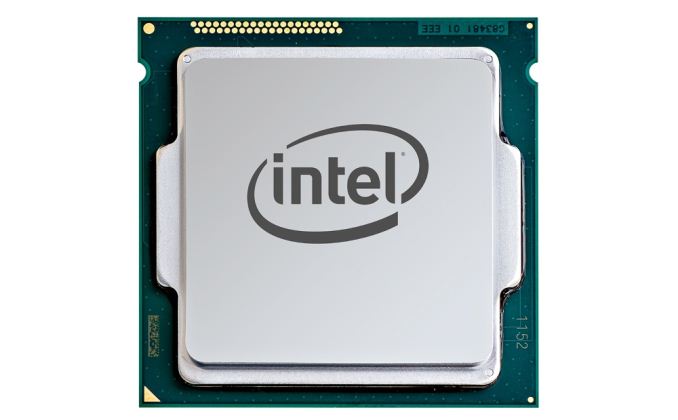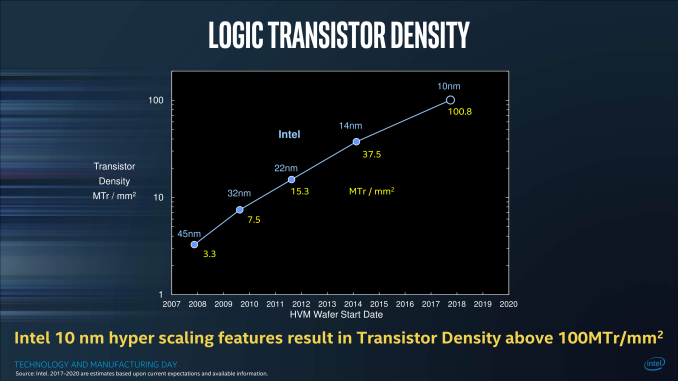Intel Officially Reveals Post-8th Generation Core Architecture Code Name: Ice Lake, Built on 10nm+
by Ian Cutress on August 15, 2017 9:20 AM EST- Posted in
- CPUs
- Intel
- Core
- Coffee Lake
- Ice Lake
- Cannon Lake

In an unusual move for Intel, the chip giant has ever so slightly taken the wraps off of one of their future generation Core architectures. Basic information on the Ice Lake architecture has been published over on Intel's codename decoder, officially confirming for the first time the existence of the architecture and that it will be made on Intel's 10nm+ process.
This is an unexpected development as the company has yet to formally detail (let alone launch) the first 10nm Core architecture – Cannon Lake – and it's rare these days for Intel to talk more than a generation ahead in CPU architectures. Equally as interesting is the fact that Intel is calling Ice Lake the successor to their upcoming 8th generation Coffee Lake processors, which codename bingo aside, throws some confusion on where the 14nm Coffee Lake and 10nm Cannon Lake will eventually stand.
As a refresher, the last few generations of Core have been Sandy Bridge, Ivy Bridge, Broadwell, Haswell, Skylake, with Kaby Lake being the latest and was recently released at the top of the year. Kaby Lake is Intel’s third Core product produced using a 14nm lithography process, specifically the second-generation ’14 PLUS’ (or 14+) version of Intel's 14nm process.
Meanwhile when it comes to future products, back at CES Intel briefly showed a device based on post-Kaby Lake designs, called Cannon Lake and based on their 10nm process. Since then Intel has also confirmed that the 8th Generation of processors for desktops, called Coffee Lake, will be announced on August 21st (and we recently received promotional material to that effect). Ice Lake then, seems poised to follow both Coffee Lake and Cannon Lake, succeeding both architectures with a single architecture based on 10nm+.
Working purely on lithographic nomenclature, Intel has three processes on 14nm: 14, 14+, and 14++. As shown to everyone at Intel’s Technology Manufacturing Day a couple of months ago, these will be followed by a trio of 10nm processes: 10nm, 10nm+ (10+), and 10++,
On the desktop, Core processors will go from 14 to 14+ to 14++, such that we move from Skylake to Kaby Lake to Coffee Lake. On the Laptop side, this goes from 14 to 14+ to 14++/10, such that we move from Skylake to Kaby Lake to Coffee Lake like the desktops, but also that at some time during the Coffee Lake generation, Cannon Lake will also be launched for laptops. The next node for both after this is 10+, which will be helmed by the Ice Lake architecture.
| Intel's Core Architecture Cadence | |||||
| Microarchitecture | Core Generation | Process Node | Release Year | ||
| Sandy Bridge | 2nd | 32nm | 2011 | ||
| Ivy Bridge | 3rd | 22nm | 2012 | ||
| Haswell | 4th | 22nm | 2013 | ||
| Broadwell | 5th | 14nm | 2014 | ||
| Skylake | 6th | 14nm | 2015 | ||
| Kaby Lake | 7th | 14nm+ | 2016 | ||
| Coffee Lake | 8th | 14nm++ | 2017 | ||
| Cannon Lake | 8th? | 10nm | 2018? | ||
| Ice Lake | 9th? | 10nm+ | 2018? | ||
The way that the desktop and laptop markets will be diverging then converging is confusing a lot of people. Why is the laptop market splitting between 14++ and 10, and why is the desktop market not going to 10nm but straight to 10+? What lies beyond is a miasma of guess work, leaked slides, and guessing Intel’s strategy, but I believe the answer lies in Intel’s manufacturing technologies and the ability to move to newer lithographic nodes.
(We should interject here that the naming of a lithographic node has slowly lost its relevance between the features of the process and the actual transistor density and performance, such that TSMC’s improved 16FF+ is called 12FFN, but relies on similar transistor sizes with enhanced attributes. But 12 is a smaller number than 14, which is the marketing angle kicking in. By all accounts, Intel has typically been considered the more accurate foundry when it comes to numerical lithographic naming of the process, which others consider is to their detriment.)
Intel originally predicted that they would move to 10nm almost a year ago, at the end of 2016 and 2 years after the launch of their 14nm process. But the challenge in managing the technology required to advance to their version of 10nm has been fraught with difficulty. In all cases it can depend on external equipment, fine tuning a process, or getting acceptable yields – while one manufacturer might be satisfied with an 80% yield, another might consider that a failure. Being able to obtain high yields (ramp up) will also be a function of die size, and so the newest nodes are typically launched with smaller mobile parts in mind first, as the yields for smaller parts are better than larger parts at the same defect rate.
Simply put, the first generation of 10nm requires small processors to ensure high yields. Intel seems to be putting the smaller die sizes (i.e. anything under 15W for a laptop) into the 10nm Cannon Lake bucket, while the larger 35W+ chips will be on 14++ Coffee Lake, a tried and tested sub-node for larger CPUs. While the desktop sits on 14++ for a bit longer, it gives time for Intel to further develop their 10nm fabrication abilities, leading to their 10+ process for larger chips by working their other large chip segments (FPGA, MIC) first.
From a manufacturing standpoint, Intel has been using multiple patterning techniques in its 14nm processes, and the industry is looking to when the transition to EUV will take place. Anton has some great writeups of the state of EUV and how different companies are transitioning to smaller nodes - they are well worth a read.
- EUV Lithography Makes Good Progress, Still Not Ready for Prime Time
- Samsung and TSMC Roadmaps: 8 and 6 nm Added, Looking at 22ULP and 12FFC
- GlobalFoundries Updates Roadmap: 7 nm in 2H 2018, EUV Sooner Than Later?
The crux of the matter is that EUV would shorten time to market and arguably make the process easier (if only more expensive), and several fab companies are waiting for Intel to jump onto it first. With EUV not ready, Intel has had to invest into deeper multi-patterning techniques, which raise costs, decrease yields, and increase wafer process times considerably.
All of which leads to a miasma of increased delays, much to the potential chagrin of investors but also customers who had banked on the power improvements that a typical new lithography node brings. Intel is still keeping spirits high, by producing numbers that would suggest that their methodology is still in tune with Moore’s Law, even if the products seem to be further strung out. Some analysts concur with Intel’s statements, while others see it as hand-waving until 10/10+ hits the market. Intel would also point out that it is developing other technologies such as Embedded Multi-Die Interconnect Bridges (EMIB) to assist in equipping chip with high-speed fabric or glue-logic.
Given its position as a post-8th gen architecture, Ice Lake is likely to hit sometime in 2018, perhaps 2019, depending on Intel’s rate of progress with larger chips and the 10+ process. Intel’s other market segments, such as FPGAs (Altera), Xeon Phi (MIC) and custom foundry partners, are also in the mix to get into some 10nm action.
(Note that Intel’s next generation of Xeon Scalable Processors is called Cascade Lake, a 2018 refresh of the Skylake generation launched this year.)
Source: Intel


















106 Comments
View All Comments
MonkeyPaw - Tuesday, August 15, 2017 - link
Kinda what I was thinking. Why would Intel tip its hand that far down the road if it wasn't an attempt to tell investors that they "still got it." AMD should honestly never be able to compete with Intel in the first place. Intel has a 14x higher market cap. The amount of resources at their disposal should have them so far ahead of anything AMD can produce. Intel has stumbled on process advancements, which has been their strongest advantage.tamalero - Tuesday, August 15, 2017 - link
More like they didnt really NEED to invest hard again. They could milk the cow.Just like they love to force complete motherboard changes almost every iteration.
jardows2 - Tuesday, August 15, 2017 - link
I would say it's more likely they used their resources to diversify outside of their core strength. How much was spent trying to make Atom a viable competitor to ARM?FreckledTrout - Tuesday, August 15, 2017 - link
Who says Intel isn't that far ahead? Honestly there IceLake design and 10nm likely have been tape in ready for a while now. If you have no competition why compete with yourself? Just keep your new stuff in your pocket until you have to pull ahead in the race again. At least AMD is forcing Intel to move forward again. I build myself a Ryzen R7 system so no bias just reality.Lolimaster - Wednesday, August 16, 2017 - link
Jim Keller is known as the GOD of cpu's for a reason.Athlon
Athlon XP
Athlon 64/Opteron
Zen
halcyon - Wednesday, August 16, 2017 - link
The ideal time to upgrade always changes.- 2018: Coffee Lake (perhaps Ice Lake, we'll see)
- 2018: nvme 1.3 drives (let's see if they matter)
- 2018: nVidia Volta gaming cards
- 2019: PCIe 4.0 (probably not available in 2018, but we'll see)
- ????: Prices of DRAM come back to earth (?)
Of course, process nodes, perf/$, perf/W and many other factors go into this.
I was really waiting for ThreadRipper and it didn't disappoint. Yet, I want to see the Intel September releases.
The only thing holding me back is PCIe 3.0, which is on it's last legs. My last system is from 2009 (using PCIe 2.0) and is doing fine otherwise (6-core 4.2Ghz), and I do feel the difference comparred to PCIe 3.0 systems I use.
Also, the DRAM prices currently are insane. Hoping the production/markets stabilize in 2018.
nevcairiel - Tuesday, August 15, 2017 - link
Perhaps 10nm Cannon Lake has been canceled, and moving straight to 10+ instead. Previous reporting has said that an early 10nm process may barely outclass the fully optimized 14++ process.Otherwise the generation naming just doesn't make any sense.
nevcairiel - Tuesday, August 15, 2017 - link
On the other hand, a 10th generation CPU is still the successor of the 8th generation, isn't it.jabbadap - Tuesday, August 15, 2017 - link
Well yeah. But ain't Cannon Lake just plain 10nm die shrink of 14nm Coffee Lake(heck coffee lake is just optimized sky lake). Like Broadwell was to Haswell. Maybe it's exactly like Broadwell: short living low tdp processors with iris pro igpus. Great for htpc users, but mainly meh for anything else.nevcairiel - Tuesday, August 15, 2017 - link
Even then Broadwell got its own generation number though.